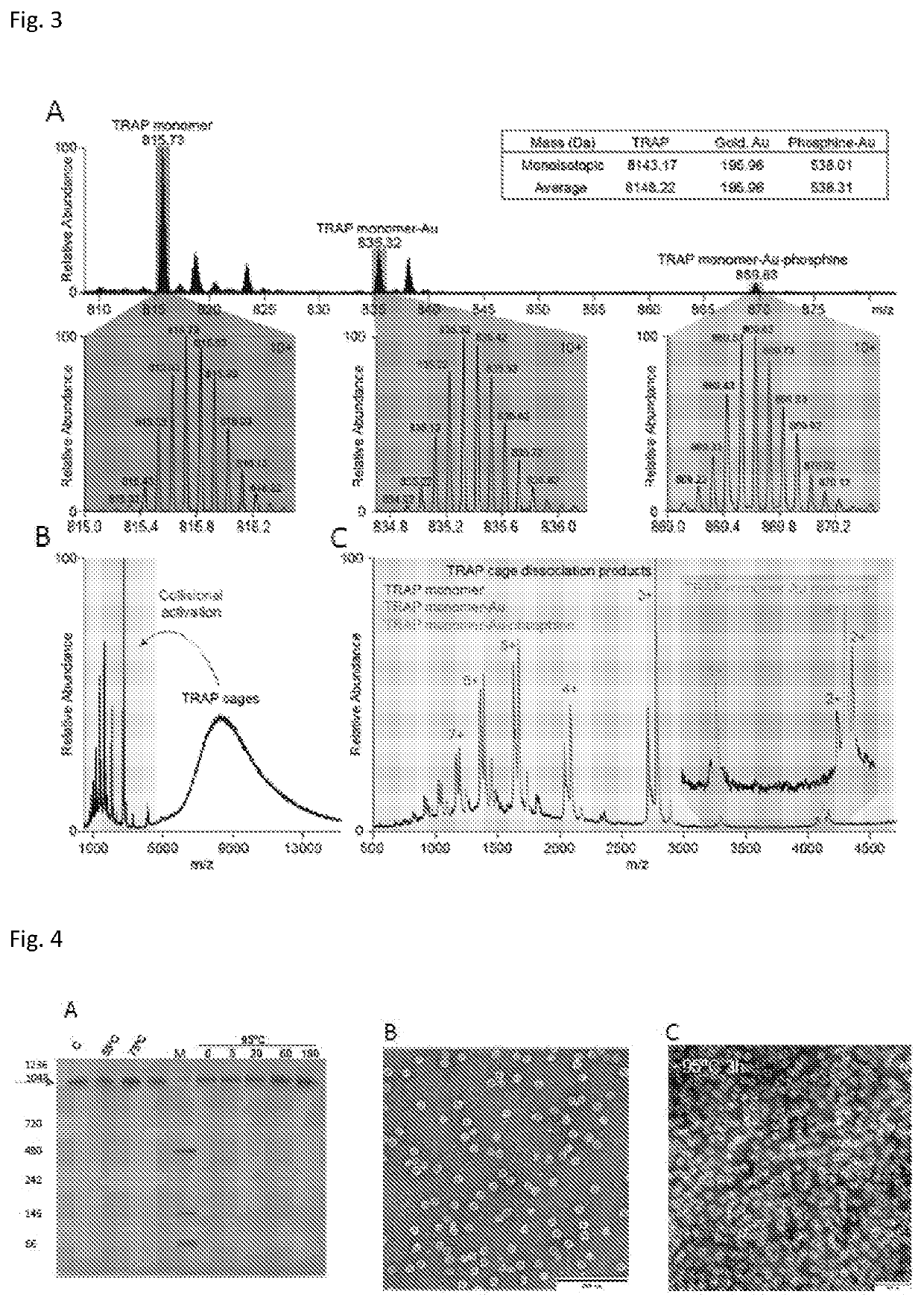Method for conjugation of biomolecules and new use of gold donor for biomolecular complex formation
- Summary
- Abstract
- Description
- Claims
- Application Information
AI Technical Summary
Benefits of technology
Problems solved by technology
Method used
Image
Examples
example 1
[0071]TRAP Complex Preparation—Reaction with Au-TPPMS
[0072](see FIG. 1)
[0073]Gold Compounds:
[0074]Chloro[diphenyl(3-sulfonatophenyl)phosphine]gold (I), sodium salt hydrate (Au-TPPMS, MDL number MFCD19443491) was purchased from STREM chemicals UK, limited and was made up to the desired concentration (typically 5 mM) by dissolving in water. The gold nanoparticle (GNP) used was a diphenyl(m-sulfonatophenyl)phosphine-gold nanocluster with a 1-3 nm core diameter (MDL number MFCD17018839) from STREM Chemicals UK.
[0075]TRAP Preparation:
[0076]The protein used that exemplifies the successful use of Au-TPPMS was TRAP protein with an introduced cysteine. Expression and purification of TRAP containing the mutation of residue lysine (K) number 35 to cysteine and an additional mutation of residue arginine (R) 64 to serine (S) (called “TRAP-CS”) was similar to as described previously for TRAP-CS11 (and as detailed above) with the notable change that TCEP (tris(2-carboxyethyl)phosphine) was not inc...
example 2
[0080]TRAP Complex Preparation—Reaction with Au(I)-Triphenylphosphine
[0081]A similar reaction can be carried out with triphenylyphosphine gold(I) chloride (Au-TPP, FIG. 1B) instead of Au-TPPMS. Au-TPP is dissolved in DMSO and the reaction is carried out in 50 mM Tris, 150 mM NaCl, pH 7.9 and Au-TPP, with DMSO not exceeding 10% of the final volume and the TRAP monomer is present at a concentration of approximately 1 mM. Ratios of Au-TPP to TRAP range from 4:2 to 4:3. This also results in TRAP-cage formation with the same structure as obtained in the reaction with Au-TPPMS. The amounts of the reagents were adjusted respectively. The ratio of the TRAP monomer / gold donor and conditions of the reaction were the same as in the reaction where Au-TPPMS was the gold-donor.
[0082]Two examples with different halogen(triarylphosphine)gold (I) gold-donor agents were performed above. It shows that halogen(triarylphosphine)gold (I) with different aryl moiety are suitable for the complex formation a...
example 3
[0083]Confirmation of TRAP-Complex Structure Using Cryo-EM
[0084]The initial (low resolution) cryo-EM structure of TRAP-cage was obtained using cryo-EM single particle reconstruction techniques for TRAP-cage formed using GNPs.10,11 and this structural data was used as an initial model for solving the high-resolution cryo-EM structure of TRAP-cage formed in the reaction with halogen(triarylphosphine)gold (I) obtained according to the invention.
[0085]Cryo-EM was used to solve the structure of the TRAP-cage to 3.9 Angstrom resolution. This was sufficient to show the arrangement of the 24 TRAP rings and to demonstrate the presence of a linking density (assigned to Au) between opposing cysteine side chains of the rings (See FIG. 2).
[0086]FIG. 2. illustrates the gold-stitching reaction and an example of the resulting complex formed. FIG. 2A shows structure of a single TRAP ring (pdb 4v4f) shown in two mutually orthogonal views. Mutated residues 35 and 64 are shown as spheres on each TRAP m...
PUM
| Property | Measurement | Unit |
|---|---|---|
| Time | aaaaa | aaaaa |
| Dimensionless property | aaaaa | aaaaa |
| Dimensionless property | aaaaa | aaaaa |
Abstract
Description
Claims
Application Information
 Login to View More
Login to View More - R&D
- Intellectual Property
- Life Sciences
- Materials
- Tech Scout
- Unparalleled Data Quality
- Higher Quality Content
- 60% Fewer Hallucinations
Browse by: Latest US Patents, China's latest patents, Technical Efficacy Thesaurus, Application Domain, Technology Topic, Popular Technical Reports.
© 2025 PatSnap. All rights reserved.Legal|Privacy policy|Modern Slavery Act Transparency Statement|Sitemap|About US| Contact US: help@patsnap.com


